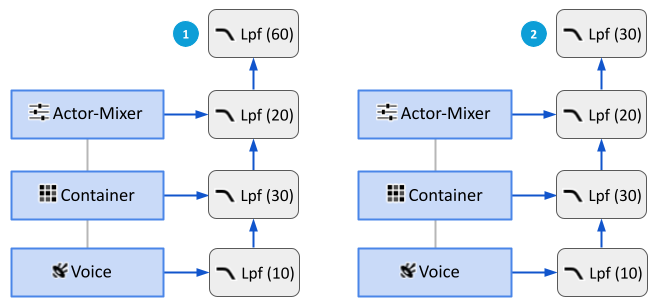Version
The cumulative behavior of filter properties, such as Low-pass filter and High-pass filter, can be set to one of two possible methods:
Sum All Values: The property values are accumulated via addition.
Use Highest Value: The property values are accumulated by retaining the highest value.
The filter behavior is defined for the entire project, and applies to the properties listed below.
Low-pass filter.
High-pass filter.
Output Bus Low-pass filter.
Output Bus High-pass filter.
User-defined Auxiliary LPF 0.
User-defined Auxiliary LPF 1.
User-defined Auxiliary LPF 2.
User-defined Auxiliary LPF 3.
Game-defined Auxiliary Sends LPF.
User-defined Auxiliary HPF 0.
User-defined Auxiliary HPF 1.
User-defined Auxiliary HPF 2.
User-defined Auxiliary HPF 3.
Game-defined Auxiliary Sends HPF.
To configure your project's filter behavior, refer to Configuring Filter Behavior.
The illustration below demonstrates how the property values are accumulated within the project hierarchy.

|
Filter accumulation methods. In this example, each object specifies a value for the Low-pass filter property. The Low-pass filter value applied to the sound depends on the accumulation method. | |
 |
Sum All Values. The Low-pass filter property values of each object are summed. |
 |
Use Highest Value. The highest of all of the object Low-pass filter properties is used. |
Questions? Problems? Need more info? Contact us, and we can help!
Visit our Support pageRegister your project and we'll help you get started with no strings attached!
Get started with Wwise